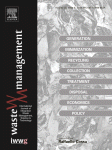Italian WEEE management system and treatment of end-of-life cooling and freezing equipments for CFCs removal.
 Author(s): SANSOTERA M., NAVARRINI W., TALAEEMASHHADI S., VENTURINI F.
Author(s): SANSOTERA M., NAVARRINI W., TALAEEMASHHADI S., VENTURINI F.
Source: Waste management (New York, N.Y.).
DOI: 10.1016/j.wasman.2013.03.012 (2013).
ABSTRACT:
This study presents and analyzes the data of the Italian system for take-back and recovery of waste electrical and electronic equipments (WEEEs) in the start-up period 2008-2010. The analysis was focused particularly on the data about the treatment of end-of-life cooling and freezing equipments. In fact, the wastes of cooling and freezing equipments have a high environmental impact. Indeed, in their compressor oil and insulation polyurethane (PU) foams chlorofluorocarbon (CFC) ozone-depleting gases are still present. In the period 2001-2004 Northern Italy resulted the main source in Europe of CFCs. The European Directive on WEEE management was enacted in 2002, but in Italy it was implemented by the legislative Decree in 2005 and it became operational in 2008. Actually, in 2008 the national WEEE Coordination Centre was founded in order to organize the WEEE pick-up process and to control collection, recovery and recycling targets. As a result, in 2010 the average WEEE collection per capita exceeded the threshold of more than 4 kg per inhabitant, as well as cooling and freezing appliances represented more than one fourth of the Italian WEEE collection stream. During the treatment of end-of-life cooling and freezing equipments, CFCs were recovered and disposed principally by burner methods. The analyses of defined specimens collected in the treatment facilities were standardized to reliably determine the amount of recovered CFCs. Samples of alkaline solid salt, alkaline saline solution, polyurethane matrix and compressor oil collected during the audit assessment procedure were analyzed and the results were discussed. In particular, the analysis of PU samples after the shredding and the warm pressing procedures measured a residual CFCs content around 500-1300 mg/kg of CFCs within the foam matrix. http://www.sciencedirect.com/science/article/pii/S0956053X13001542


